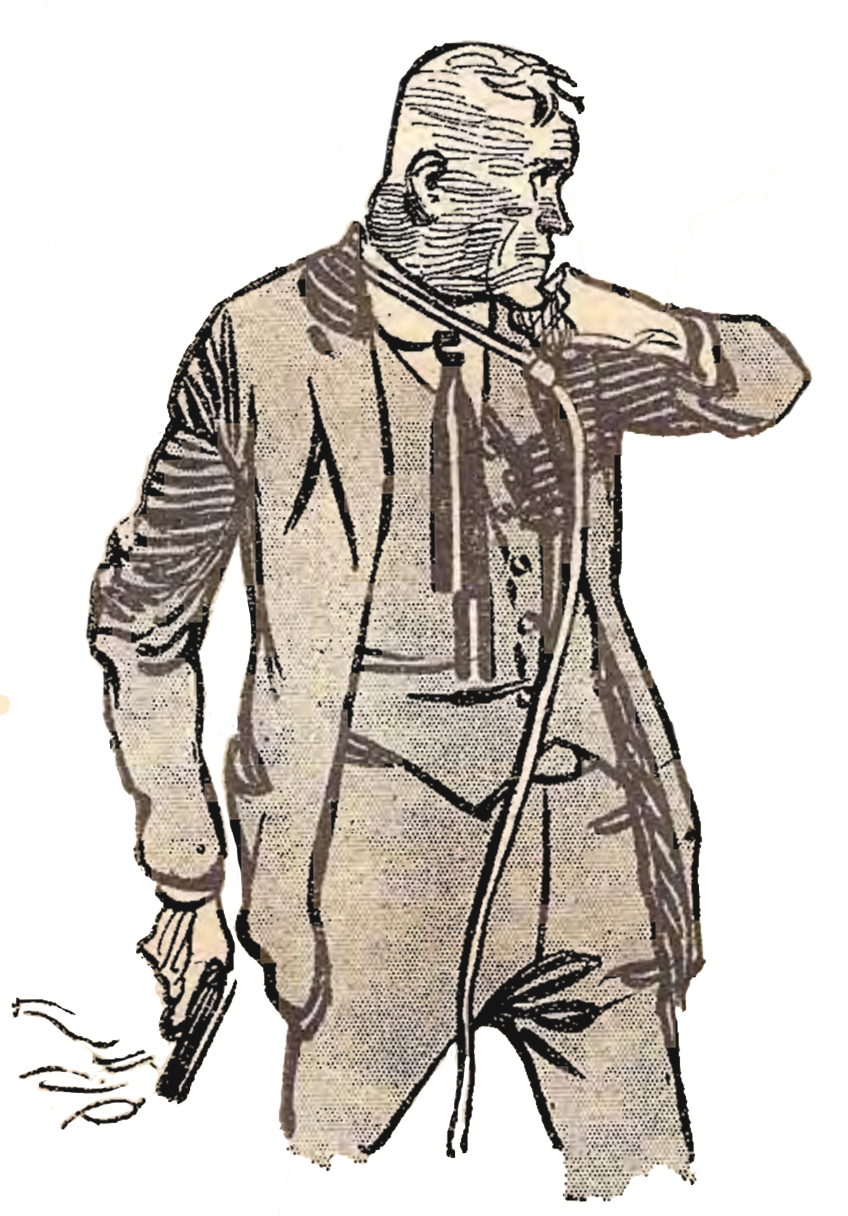RUFF HANSON
by Mark Hodder
Ruff Hanson is a private investigation agent from New York. He is sometimes called the Silent Sleuth or Hard Boiled Hanson. His significant others are his guns, Willy and Wally.
The character was created by Gwyn Evans.

Ruff Hanson, confidential agent, the Silent Sleuth, is a man of few words and hard action. He is tall, burly and broad-shouldered, weighs about a hundred and fifty pounds, and cannot, by any stretch, be regarded as good looking. His face is rugged, with a craggy jaw and piercing blue eyes; ugly but curiously likeable. In personality, he is guileless, breezy and affable, but radiates forcefulness and is definitely not to be crossed. He is absolutely devoid of fear and straight as a die. Women, perhaps, are the only thing that can unnerve him, which is why he regards them as decorative but best avoided.
Hanson has a couple of pals who do all his talking for him: his six-guns, Willy and Wally. He is astonishingly quick on the draw and is a marksman of unparalleled ability, able to shoot a cocktail cherry from the stem of a wine glass placed on a man's head from across a room and with his back turned!
Chronology
Guns is Guns (THE UNION JACK issue 1,173, 1926)
An actress, Haseena, is being blackmailed by a man named Folair. She commissions Ruff Hanson to help her out but Folair ends up dead and Hanson has no idea who did the killing. He begins to suspect that Haseena is more than she seems. He is then hired by a steel magnate whose daughter has run off to Syria with a prince named Ali Khan. Hanson goes to Syria and falls in with Sexton Blake and Splash Page who are there to prevent a rebellion. When they capture its leader, Hanson recognises him as Ali Khan. Blake helps to locate the missing girl. Hanson shoots Khan dead. Blake reveals the link between Haseena, Folair and Khan.
The Secret of Shakespeare's Skull (THE UNION JACK issue 1,192, 1926)
Ruff Hanson Runs Amok (THE UNION JACK issue 1,193, 1926)
Mrs. Bardell's Christmas Eve (THE UNION JACK issue 1,210, 1926)
Hanson is spending Christmas at Baker Street with Blake, Tinker, Splash Page and Detective-Inspector Coutts. Tinker and Page seek to create a sensation by inventing a character — The Phantom Crook — to challenge the detectives. The fake villain's crimes include the theft of a valuable coronet and the kidnapping of Mrs Bardell. Hanson sees through the scheme and joins the fun.
The Gallows Mystery (THE UNION JACK issue 1,235, 1927)
Hanson is in Boravia to investigate the source of illegal alcohol that's being smuggled to the States. When he saves King Karl from an assassin, the monarch reveals his identity as "Ace," the leader of the notorious criminal gang known as the Double Four, and asks Hanson to join it. Hanson, who has encountered Sexton Blake in a hotel and knows the detective is investigating the gang, agrees to the proposal.
The Return of Sexton Blake (THE UNION JACK issue 1,236, 1927)
Eclipse! (THE UNION JACK issue 1,237, 1927)
The Mystery of the Ivory Beam (THE UNION JACK issue 1,238, 1927)
The Affair of the Black Carol (THE UNION JACK issue 1,260, 1927)
Hanson is hired to guard the son of a film producer, Benjamin Cayterer, who fears that his boy is about to be kidnapped. Blake, Tinker, Spash Page and Detective-Inspector Coutts join Hanson at Cayterer's mansion, where Christmas is celebrated with a Dickensian fancy dress theme. When Cayterer junior is snatched from his room, investigations lead nowhere until Hanson sees a ghost, follows it, and uncovers a smuggling operation. While he rounds up the gang, Blake seeks the missing boy ... who is discovered and rescued by Mrs Bardell.
Exposure! (THE UNION JACK issue 1,337, 1929)
The Mistletoe-Milk Mystery (THE UNION JACK issue 1,365, 1929)
The Masque of Time (THE UNION JACK issue 1,366, 1929)
The Mystery of the Wailing Wall (THE UNION JACK issue 1,369, 1930)
The Six Green Arabs (THE UNION JACK issue 1,370, 1930)
The Ghost Mobile (THE UNION JACK issue 1,467, 1931)
